Analytics » What is a Table » Working with Tables
Working with Tables
Virtutem Analytics offers a range of interactive options to work with a table. Some of the options include Filter, Sort, Format, Find and Replace values, Freeze and Show/Hide Columns. Virtutem Analytics also allows to Export, Share and Publish a table.
| Note: |
|---|
These options will be enabled only to users who have been provided with appropriate permissions during sharing by the Administrator. Refer to the topic Sharing and Collaboration to know more about sharing. |
Virtutem Analytics allows you to quickly search for specific records with in a large set of data. Search box on the toolbar can be used to locate records in a table that matches the keyword that you specify.
To search for records, type the keyword that you want to search for in the search box and click on the magnifying glass icon ( ![]() ) next to the search box. All the records containing the specified keyword will be filtered and displayed as shown below. Note that the search operation will search across data contained in all columns of the table.
) next to the search box. All the records containing the specified keyword will be filtered and displayed as shown below. Note that the search operation will search across data contained in all columns of the table.

Virtutem Analytics provides a Filter option to easily filter records in your table based on criteria that you specify. Depending on the data type of the column, Virtutem Analytics offers various filtering options like filter based on specific numeric ranges, date ranges, individual values, partial match etc. Virtutem Analytics also allows to apply filters on multiple columns at a time.
Filter Pane Options:
Following is a brief description of various options provided in the Filter Pane when you apply filters.
Hide: Click this option to hide filter pane. You can also use
 icon at the column header to hide/show filter pane.
icon at the column header to hide/show filter pane. Clear: Click this option to remove all the filters applied.
Save/Save as: Click this option and type the name in the dialog box that appears to save your filter for later/repeated use. How to save a filter for repeated usage is discussed below.
Delete Rows: Select this option to permanently delete the filtered rows from the table.
Virtutem Analytics allows you to rearrange rows in a table by sorting values in one or more of its columns.You can sort a column numerically,alphabetically or by date depending on its data type. For example you can sort a column of dates by their date order, while a column of numbers can be sorted numerically.
The sort options available in Virtutem Analytics are:
Sort Ascending - Sorts text data in ascending alphabetical order (A to Z), numbers from smallest to largest (0-9) and dates from oldest to latest.
Sort Descending - Sorts text data in descending alphabetical order (Z to A), numbers from largest to smallest(9-0) and dates from latest to oldest.
Find and replace option can help you to locate a value in a column and replace it with another value. This feature can be very useful especially when you are working with large sets of data and have the need to quickly correct/rectify issues in your data set.
| Note: |
|---|
This option will be enabled only to users who have been provided Write permission by the Administrator. |
Options in the Find and Replace
Bulk Update: Select this option if you want to replace all the values in the column with the value specified in the Replace With text box. On selecting this option the Find what text box will be disabled.
Match entire cell contents: Select this option to limit your search results only to cells whose entire contents matches with the Find What value that you have provided. This option is selected by default for number and currency type columns.
Do not replace null values: Select this option when you do not want to replace existing null values in the column with the value specified in Replace With . This is applicable only when you use the Bulk Update option.
| A few points to note: |
|---|
|
Virtutem Analytics let you show or hide columns in a table view.
Freeze Column option allows you to keep specific columns always visible in the table even when you scroll horizontally across the screen. For example, you can freeze columns that identifies the records (Ex:- Customer Name, Product ID) in a table so that you can keep track of a record that you are looking, even when you scroll off to the right-most column in the table.
Virtutem Analytics allows you to rearrange the order of columns in a table using drag and drop.
Each column has a set of properties like format, name, data type etc. Column Properties option in the toolbar provides you with options to change these properties any time you want after creating a column.
Virtutem Analytics offers options to change the format of a column like alignment, decimal places, date formats, currency symbol etc., depending on its data type. Using these options you can choose how you would like to have your column data displayed in your table.
| Note: |
|---|
Option to format columns will be disabled for shared users. |
Formatting options provided in the dialog box changes based on the data type of the selected column. The following table gives a brief description of these options.
| Numeric Data Type | |
| OPTION | DESCRIPTION |
| Alignment | This option can be used to horizontally align the value in the cell. Possible values are left , right and center . |
| Separator | This option allows you to pick a decimal and thousand separator to be used . Apply User Locale Settings - You can select this option to use separators based on the locale settings of the user. For example, in US locale a comma will be used for a thousands separator and in case of German locale a dot will be used . Thousand - This option can be used to select the type of thousand separator. This option will be enabled for number and decimal type columns. This option will be disabled when you have choosen . Apply User Locale Settings mentioned above. Available options include: Comma, Dot, Space and Single Quote Decimal - This option can be used to select the type of decimal separator. This option will be available only for decimal, currency and percentage columns. Also, this option will be disabled when you have choosen . Apply User Locale Settings mentioned above. Available options include Dot and Comma. |
| Currency Symbol | This option enables you to choose the type of currency symbol displayed. You can select the currency symbol you want from the wide variety of symbols available in the drop down list. This option will be enabled for currency type columns. |
| Negative Number Display | This options allows you to specify how negative numbers are to be displayed Options available are:
|
| Decimal Places | You can use this option to set the number of decimal places to display for decimal, currency and percentage columns. |
| Date Data Type | |
| OPTION | DESCRIPTION |
| Alignment | This option can be used to horizontally align date in the cell. Possible values are left, right and center. |
| Choose Date Format | This option allows you to pick the date format you want, for displaying dates values, from the given list. |
| String/Category Data Type | |
| OPTION | DESCRIPTION |
| Alignment | This option can be used to horizontally align the text in the cell. Possible values are left, right and center. |
| URL Data Type | |
| Alignment | This option can be used to horizontally align the text in the cell. Possible values are left, right and center. |
| Alternate Text | This option allows you to provide a substitute reader-friendly text that will be shown instead of the actual URL. |
| A few points to note on the behavior of the Alternate text (for URL data type columns) feature in various scenarios |
|---|
|
Conditional formatting feature allows you to highlight cells in a column with different background and font colors based on a condition. You have to specify the required conditions/criteria for formatting. When data in a cell meets the condition, Virtutem Analytics applies the corresponding formatting style that you have specified. Conditional formatting is currently supported in Tables, Tabular Views and Query Tables.
To apply conditional formatting:
Select the column (by clicking the header) on whose cells you want to apply conditional formatting.
Either right click to get the pop-up menu or invoke Column Properties option in the toolbar.
In the menu, select Conditional Formatting option a shown below.
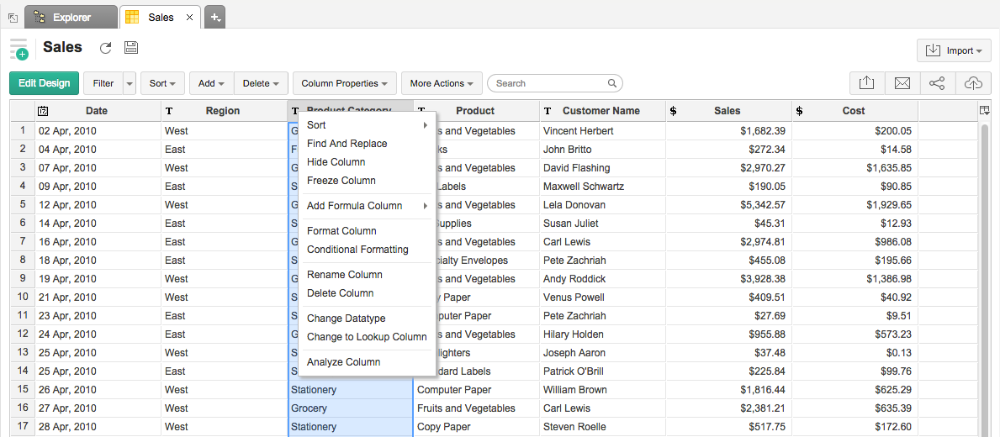
A dialog box appears with options for specifying the conditions and selecting colors for font and background.
Click the drop down arrow under Condition header and select the type of the condition that you want to apply.
Type the matching value that you want to use for the condition in the Value text box.
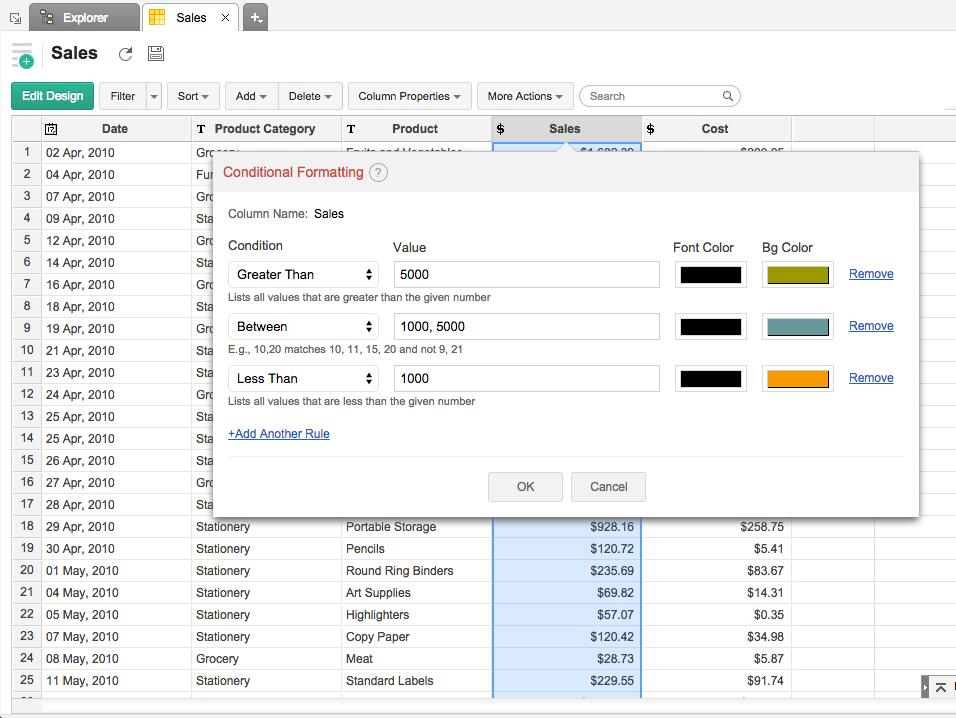
Select the required colors for the font and background.
You can add any number of conditions using +Add Another Rule option at the bottom of the dialog box.
Click OK after you have added all the conditions.
All the cells that meets the criteria will be formatted accordingly.
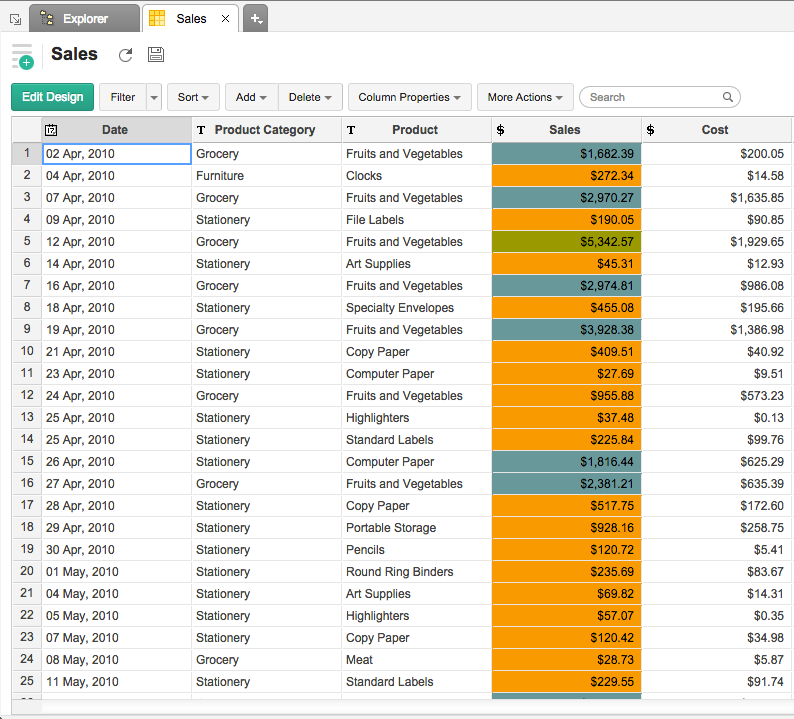
| Note: |
|---|
Conditional Formatting option will be disabled for shared users. |
In Virtutem Analytics changing a column's name is easy. You can rename as given below:
| Note: |
|---|
Rename Column option will be disabled for shared users. |
After creating a table, it is common for you to feel the need to change an already existing column's data type. Let us suppose you initially defined a column to hold text data, you realize later that it actually contains numeric data. In such cases, Virtutem Analytics provides you with an option to change the columns data type with out loosing data in it. However, when changing a column's data type, all the data existing in the column must be compatible with the new data type.
Changing the data type of a column could result in failures. Change Datatype dialog box lists down the action to be taken in case an error occurs during conversion. The options are:
Set the default value for the column in the corresponding record: Column values will be replaced with column's default value. You can view/edit column's default value using Edit Design in the toolbar.
Set empty value for the column in the corresponding record: For every row that fails during conversion the corresponding column value will be set to empty (NULL).
Stop conversion and rollback the changes: The entire conversion will be aborted and the changes done till then will be rolled back.
Virtutem Analytics provides the above options to effectively handle possible errors during conversion. For example, when you try to convert a Number data type column to Positive Number data type, in case the Number type column does not contain any negative values, then the conversion will take place with out any error. In case the column has negative values, error would occur on converting the column to a Positive Number. In such scenarios the above mentioned options enables you to choose the appropriate action to be taken on errors during conversion.
After choosing a data type for your column, click OK.
| Note: |
|---|
|
Lookup column relationships in Virtutem Analytics are similar to Foreign key relationships in Relational Database. A lookup column is a type of column whose values will be referenced from a column in another table in the same database i.e., it can be used to cross-reference tables in a database. Refer to the topics Relational Data Modeling and Joining Tables to know more about lookup column.
Virtutem Analytics provides you with an option to change a column to a lookup column. To change a column to a Lookup column:
Open the required table from the reporting database.
Select the column that you want to change to a lookup column.
Select More Actions->Change to Lookup Column option on the toolbar or right click on the column and choose Change to Lookup Column option.
The Change to Lookup Column dialog box will open as shown below with Column to Lookup option which lists all the tables and their columns in the database as drop-down list.
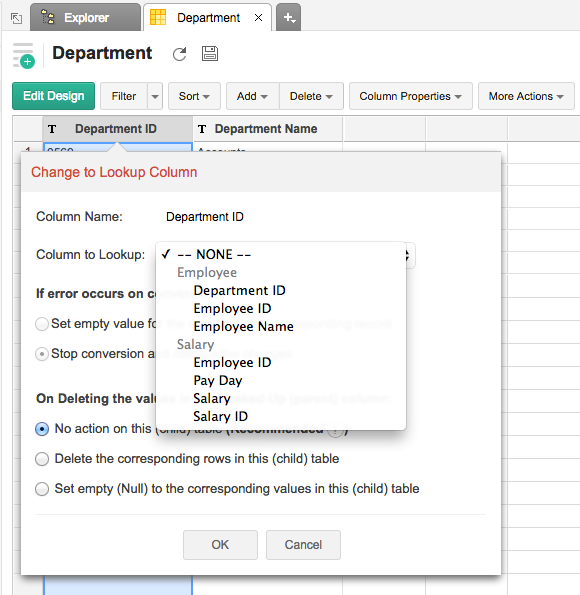
Select the column to lookup from the list.
The Change to Lookup Column dialog also provides options on how to handle errors during conversion and options to define the behaviour when a row in the parent table is deleted. Here is a rundown of the options provided:
If error occurs on conversion?
Changing a column to a Lookup could result in failures. This option lists down the action to be taken in case an error occurs during Lookup column conversion. The options are:
Set empty value for the column in the corresponding record: For every row that fails during conversion the corresponding lookup column value will be set to empty (NULL).
Stop conversion and rollback the changes: If an error occurs during conversion the entire conversion will be aborted and the changes done will be rolled back. This way the table will retain the existing design & values without any lookup column being created and no changes done.
On Deleting the values in the Lookup (parent) column:
This section provides options to choose an action to be taken in the child table (table in which you define the lookup) when a records are deleted in the Parent table (the table which you are looking up). These options are discussed in detail under Enforce Data Integrity section of Relational Data Modeling topic.
Select the required options and then click OK.
| Note: |
|---|
|
Virtutem Analytics can automatically analyze your column's data and create sample reports by picking the meaningful metrics. You can get started with these reports or modify them or create your own. To analyze your column and create reports.
Select a column by clicking on its header and right click on the header.
In the right click pop-up menu select Analyze Column option as shown below.
On successful completion of analysis, tables reports will be generated.
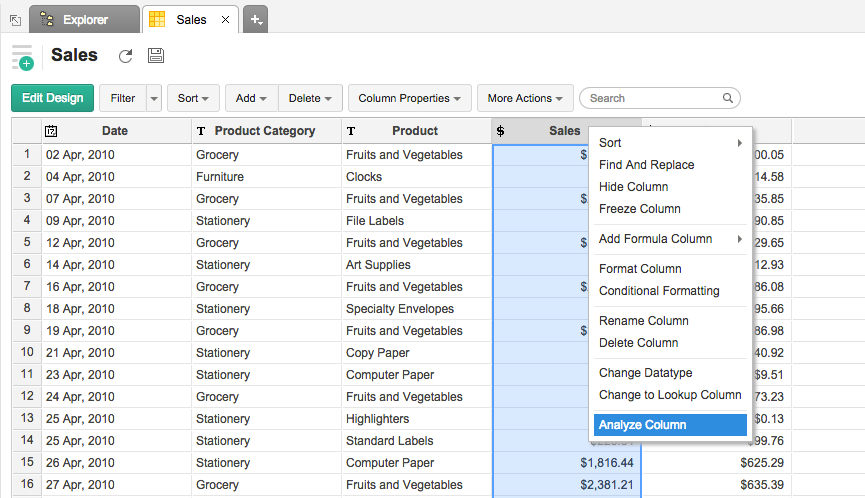
| Note: |
|---|
|
Virtutem Analytics allows you to export tables that you have into various file formats like CSV, PDF, XLS or HTML files.
To export a table:
Open the table that you would like to export.
Select Export in the toolbar.
Select one of the five export format options:
CSV -Exports the table's data as a Comma Separated Value (CSV) file.
PDF - Exports the table's data in Portable Document Format (PDF) file format.
HTML - Exports the table's data in HTML file format.
Excel (XLS) - Exports table as a Excel file.
In the Export Settings window that opens, set the required options and then click Export button at the bottom to export.
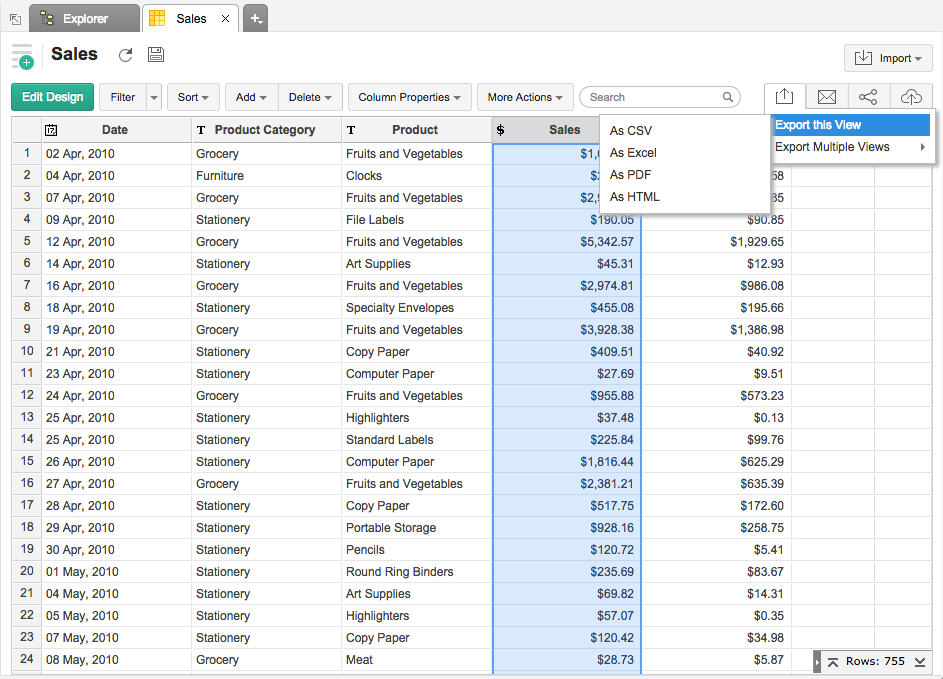
In Virtutem Analytics you can easily share your table for other users access. You can also set specific permissions on the shared tables, so that the users would be allowed to do only permitted actions when they access the table. The various share options are provided under the Share menu in the toolbar.
Refer to the topic Sharing and Collaboration to know how to share a table.
| Note: |
|---|
|
Virtutem Analytics allows you to publish/embed tables into your websites/web pages or as iGoogle Gadgets or as easy to access URLs. Virtutem Analytics also allows you to control the access privileges and permissions provided to the users who access the table.
Refer to the topic Publishing Options to know how to Publish a table.
| Note: |
|---|
|